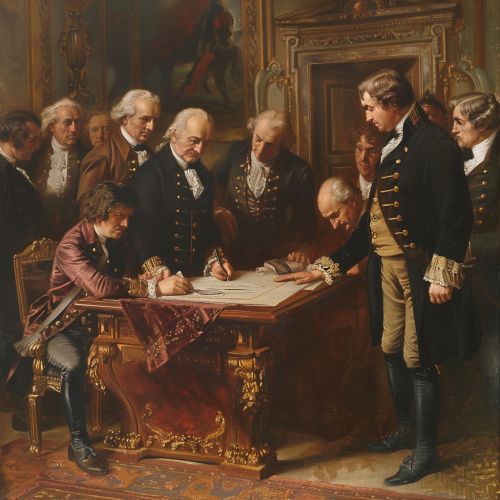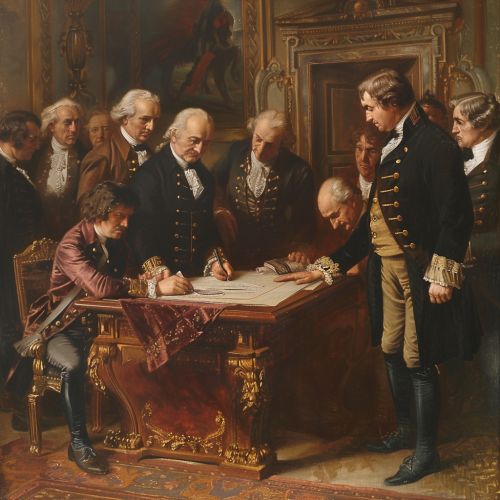Treaty of Kiel
Treaty of Kiel
The Treaty of Kiel, signed on January 14, 1814, was a pivotal agreement that concluded hostilities between the Kingdom of Denmark-Norway and the allied powers of Sweden and the United Kingdom during the Napoleonic Wars. The treaty had significant implications for the territorial rearrangement in Scandinavia and the broader geopolitical landscape of Europe.


Historical Context
The Treaty of Kiel was negotiated in the context of the Napoleonic Wars, a series of conflicts involving Napoleon Bonaparte's French Empire and various European coalitions. Denmark-Norway, initially neutral, was drawn into the conflict due to its strategic position and the interests of major powers in controlling access to the Baltic Sea. The British Royal Navy's attack on Copenhagen in 1807 and the subsequent seizure of the Danish fleet forced Denmark-Norway into an alliance with France.
Negotiations and Signatories
The treaty negotiations took place in Kiel, a city in the Duchy of Holstein, part of the Danish realm. The primary negotiators were Count Niels Rosenkrantz for Denmark-Norway, Baron Gustaf af Wetterstedt for Sweden, and Lord Cathcart for the United Kingdom. The treaty was signed by King Frederick VI of Denmark-Norway and King Charles XIII of Sweden.
Terms of the Treaty
The Treaty of Kiel contained several key provisions:
- **Cession of Norway**: Denmark-Norway ceded the Kingdom of Norway to the King of Sweden. This transfer excluded the Faroe Islands, Iceland, and Greenland, which remained under Danish control.
- **Territorial Adjustments**: Denmark retained control over the Duchies of Schleswig and Holstein. Sweden, in turn, ceded Swedish Pomerania to Denmark, although this transfer was later nullified by the Congress of Vienna.
- **Military and Naval Provisions**: The treaty stipulated the withdrawal of Danish and Swedish forces from occupied territories and the cessation of hostilities. It also included clauses regarding the exchange of prisoners of war.
Impact on Denmark-Norway
The cession of Norway marked the end of the centuries-old union between Denmark and Norway, significantly altering the political landscape of Scandinavia. The loss of Norway was a severe blow to Denmark, both economically and strategically. The Danish monarchy faced internal challenges and had to navigate a period of political and economic restructuring.
Impact on Norway
For Norway, the Treaty of Kiel was a turning point. The Norwegian nobility and populace were initially resistant to Swedish rule. This resistance culminated in the drafting of the Constitution of Norway at Eidsvoll in May 1814, declaring Norway an independent kingdom. However, following a brief conflict known as the Swedish-Norwegian War, Norway entered a personal union with Sweden, retaining significant autonomy under the terms of the Convention of Moss.
Impact on Sweden
The acquisition of Norway was a significant gain for Sweden, compensating for the loss of Finland to Russia in 1809. The union with Norway lasted until 1905, when Norway peacefully dissolved the union and declared full independence. The Treaty of Kiel thus played a crucial role in shaping modern Scandinavian borders.
Broader Geopolitical Implications
The Treaty of Kiel had broader implications for European geopolitics. It was part of the larger reorganization of Europe that took place during the Congress of Vienna (1814-1815). The treaty's provisions influenced subsequent diplomatic negotiations and territorial settlements, contributing to the reshaping of national boundaries and alliances in post-Napoleonic Europe.
Legacy
The legacy of the Treaty of Kiel is evident in the enduring political and cultural ties between Denmark, Norway, and Sweden. The treaty is a significant historical document, reflecting the complex interplay of power, diplomacy, and national interests in early 19th-century Europe. It remains a subject of study for historians and scholars interested in the Napoleonic era and Scandinavian history.
